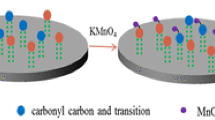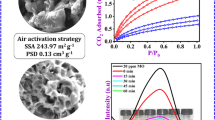Abstract
In order to enhance the oxidation and adsorption capacity of catalyst, two kinds of activated carbon (AC) are mechanically mixed with V2O5-WO3/TiO2 catalyst respectively. In this study, the mixtures (M-1: catalyst mixing with AC based on lignite; M-2: the one on coconut shell) are investigated to destroy high concentration (9.8 ng I-TEQ Nm−3) PCDD/Fs at low temperature (160 °C). Adding AC into the catalyst obviously increases removal efficiency (RE) and destruction efficiency (DE). However, M-2 presents higher RE value and lower DE value compared with M-1 at the same conditions as the stronger adsorption capacity of AC based on coconut shell. For the M-2 mixture, RE values are decreasing while DE values show an opposite trend with the ratios of catalyst to AC increasing. Oxygen plays a positive role on the destruction of PCDD/Fs by accelerating the conversion of V4+Ox and V5+Ox. Adjusting oxygen content from 0 to 20 % could increase the DE value from 27.4 to 82.2 % for the M-1 and from 15.8 to 68.9 % for the M-2. In the presence of ozone, a dark brown flock will be generated when the ratio of AC and catalyst is 4:1 due to the reaction between AC and ozone, which results in the lower RE and DE values. The RE and DE values reach the maximum of 96.3 %, 90.6 % in this paper, respectively, when the ratio of AC and catalyst is 1:1 with ozone. Finally, the regenerating of mixture is investigated. Most of dioxin residues in the mixture are desorbed and oxidized by catalysis at 200 °C in the presence of oxygen.










Similar content being viewed by others
References
Boos R, Budin R, Hartl H, Stock M, Wurst F (1992) PCDD-degradation and PCDF degradation by a SCR-unit in a municipal waste incinerator. Chemosphere 25:375–382
Chang MB, Lin JJ (2001) Memory effect on the dioxin emissions from municipal waste incinerator in Taiwan. Chemosphere 45:1151–1157
Chen T, Gu YL, Yan JH, Li XD, Lu SY, Dai H, Cen KF (2008a) Polychlorinated dibenzo-p-dioxins and dibenzofurans in flue gas emissions from municipal solid waste incinerators in China. J Zhejiang Univ Sci A 9:1296–1303
Chen T, Yan JH, Lu SY, Li XD, Gu YL, Dai HF, Ni MJ, Cen KF (2008b) Characteristic of polychlorinated dibenzo-p-dioxins and dibenzofurans in fly ash from incinerators in china. J Hazard Mater 150:510–514
Chi KH, Chang SH, Huang CH, Huang HC, Chang MB (2006) Partitioning and removal of dioxin-like congeners in flue gases treated with activated carbon adsorption. Chemosphere 64:1489–1498
Das D, Gaur V, Verma N (2004) Removal of volatile organic compound by activated carbon fiber. Carbon 42:2949–2962
Dhandapani B, Oyama ST (1997) Gas phase ozone decomposition catalysts. Appl Catal Environ 11:129–166
Finocchio E, Busca G, Notaro M (2006) A review of catalytic processes for the destruction of PCDD and PCDF from waste gases. Appl Catal Environ 62:12–20
Gao H, Ni Y, Zhang H, Zhao L, Zhang N, Zhang X, Zhang Q, Chen J (2009) Stack gas emissions of PCDD/Fs from hospital waste incinerators in China. Chemosphere 77:634–639
Goto M, Sasaki M, Kawahara S, Hirose T (2005) Adsorption behavior of dioxin model compounds on activated carbon in supercritical carbon dioxide. Adsorption 11:157–161
Ji SS, Li XD, Ren Y, Chen T, Cen KF, Ni MJ, Buekens A (2013) Ozone-enhanced oxidation of PCDD/Fs over V2O5–TiO2-based catalyst. Chemosphere 92:265–272
Ji SS, Ren Y, Buekens A, Chen T, Lu SY, Cen KF, Li XD (2014) Treating PCDD/Fs by combined catalysis and activated carbon adsorption. Chemosphere 102:31–36
Karademir A, Bakoglu M, Taspinar F, Ayberk S (2004) Removal of PCDD/Fs from flue gas by a fixed-bed activated carbon filter in a hazardous waste incinerator. Environ Sci Technol 38:1201–1207
Kawashima A, Katayama M, Matsumoto N, Honda K (2011) Physicochemical characteristics of carbonaceous adsorbent for dioxin-like polychlorinated biphenyl adsorption. Chemosphere 83:823–830
Liljelind P, Unsworthb J, Maaskant O, Marklund S (2001) Removal of PCDD/Fs and related aromatic hydrocarbons from flue gas streams by adsorption and catalytic destruction. Chemosphere 42:615–623
Lv Y, Huang J, Yu G, Yang X. (2008) Comparison of the dioxins release inventories of China and other countries. Pollution Control and Prevention 6:71–74
Sabio E, González E, González JF, González-Garcı́a CM, Ramiro A, Gañan J (2004) Thermal regeneration of activated carbon saturated with p-nitrophenol Carbon. Carbon 42:2285–2293
Tseng H, Lub C, Chang F, Wey M, Cheng H (2011) Catalytic removal of NO and PAHs over AC-supported catalysts from incineration flue gas: benchscale and pilot-plant tests. Chem Eng J 169:135–143
Wang HC, Chang SH, Hung PC, Hwang JF, Chang MB (2008) Catalytic oxidation of gaseous PCDD/Fs with ozone over iron oxide catalysts. Chemosphere 71:388–397
Wang HC, Chang SH, Hung PC, Hwang JF, Chang MB (2009) Synergistic effect of transition metal oxides and ozone on PCDD/F destruction. J Hazard Mater 164:1452–1459
Weber R, Sakurai T, Hagenmaier H (1999) Low temperature decomposition of PCDD/PCDF, chlorobenzenes and PAHs by TiO2-based V2O5-WO3 catalysts. Appl Catal Environ 20:249–256
Wielgosiński G (2010) The possibilities of reduction of polychlorinated dibenzo-p-dioxins and polychlorinated dibenzofurans emission. Int J Chem Eng 36(8):1671–5
Xu Z, Deng S, Yang Y, Zhang T, Cao Q, Huang J, Yu G (2012) Catalytic degradation of pentachlorobenzene in simulated flue gas by a V2O5–WO3/TiO2 catalyst. Chemosphere 87:1032–1038
Yan M, Li XD, Lu SY, Chen T, Chi Y, Yan JH (2011) Persistent organic pollutant emissions from medical waste incinerators in China. J Mater Cycles Waste Manag 13:213–218
Acknowledgments
This work is supported by the National Basic Research Development Program of China (973 Program No. 2011CB201500), National High Technology Research and Development Key Program of China (No. 2012AA062803).
Author information
Authors and Affiliations
Corresponding author
Additional information
Responsible editor: Ester Heath
Rights and permissions
About this article
Cite this article
Yu, Mf., Li, Xd., Chen, T. et al. Low temperature destruction of PCDD/Fs by catalysis coupled with activated carbon. Environ Sci Pollut Res 23, 5459–5467 (2016). https://doi.org/10.1007/s11356-015-5773-z
Received:
Accepted:
Published:
Issue Date:
DOI: https://doi.org/10.1007/s11356-015-5773-z




